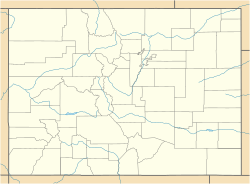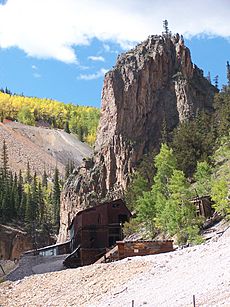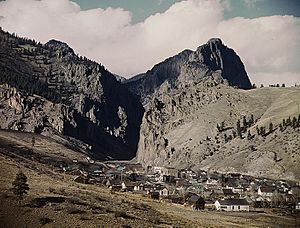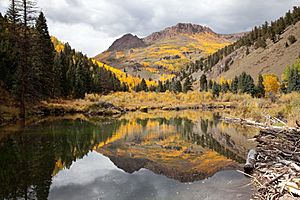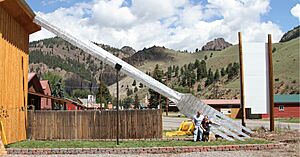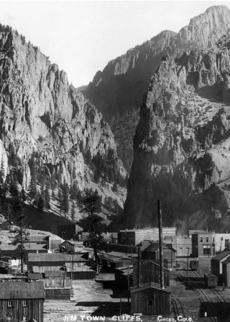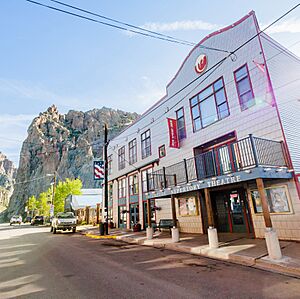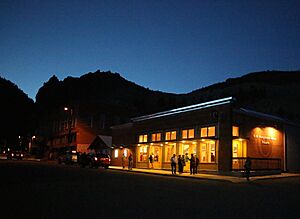Creede, Colorado facts for kids
Quick facts for kids
Creede, Colorado
|
|
|---|---|
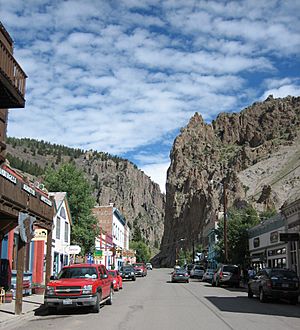
Downtown Creede (2005)
|
|

Location of the Town of Creede in the Mineral County, Colorado.
|
|
| Country | |
| State | |
| County | Mineral County seat |
| Incorporated | May 19, 1892 |
| Government | |
| • Type | Statutory Town |
| Area | |
| • Total | 0.950 sq mi (2.460 km2) |
| • Land | 0.950 sq mi (2.460 km2) |
| • Water | 0 sq mi (0.000 km2) |
| Elevation | 8,800 ft (2,700 m) |
| Population
(2020)
|
|
| • Total | 257 |
| • Density | 377/sq mi (146/km2) |
| Time zone | UTC−07:00 (MST) |
| • Summer (DST) | UTC−06:00 (MDT) |
| ZIP Code |
81130
|
| Area code(s) | 719 |
| FIPS code | 08-14765 |
| GNIS ID | 190444 |
| Website | City website |
Creede is a small town in Colorado, United States. It is known as a Statutory Town, which means it has its own local government. Creede is also the county seat of Mineral County. This means it is where the main government offices for the county are located. In 2020, about 257 people lived in Creede. It is the biggest town and the only officially recognized town in Mineral County.
Contents
History of Creede
People started visiting the Creede area in the early 1800s. In 1840, a farmer named Tom Boggs, who was related to the famous Kit Carson, grew crops nearby. The first discovery of silver happened in 1869 at the Alpha mine. However, it was hard to get the silver out of the rocks and make a profit.
In the 1870s, ranchers and homesteaders moved in. This happened as stagecoach stations were built to connect mining areas with the eastern parts of the state. The really big "Boom Days" for Creede began in 1889. This was when rich minerals were found in Willow Creek Canyon.
Creede was first located on East Willow Creek and was simply called Willow. The town's post office opened in 1891. It was renamed Creede on July 1, 1891, after Nicholas C. Creede. He was the person who discovered the famous Holy Moses Mine. Other small settlements like Stringtown, Jimtown, and Amethyst were also nearby. The town of Creede officially became a town on May 19, 1892. Soon, the whole area, from East Willow to Amethyst, was known as Creede.
In the 1800s, Creede was the last big silver boom town in Colorado. Its population grew very quickly. In 1889, only about 600 people lived there. By December 1891, more than 10,000 people had moved to Creede! The mines in Creede operated for a long time, from 1890 until 1985. Trains from the Denver & Rio Grande Railroad helped transport the minerals.
While Creede was booming, the capital city of Denver, Colorado was trying to stop gambling and saloons. Many owners of these businesses in Denver moved to Creede. One famous person who came to Creede was Soapy Smith. He was known for tricking people. Soapy became a leader in Creede's less lawful side of town and opened a club called the Orleans Club. Other well-known people in Creede included Robert Ford, who was famous for killing the outlaw Jesse James. Bat Masterson and William Sidney "Cap" Light were also there.
On June 5, 1892, a large fire destroyed most of Creede's business area. Just three days later, on June 8, Robert Ford was shot and killed by Ed O'Kelley. The town of Creede was officially incorporated on June 13, 1892. After a while, the anti-gambling efforts in Denver stopped. Many of the business owners who had moved to Creede went back to Denver.
Creede's boom time ended in 1893. This was when the Silver Panic hit the silver mining towns in Colorado. The price of silver dropped very low, and most silver mines had to close. Creede never became a completely empty "ghost town," but its population did get much smaller. After 1900, Creede survived by mining other metals like lead and zinc. Over the years, the mines produced a lot of silver, gold, lead, zinc, and copper.
Geography and Climate
Creede is located close to where the Rio Grande river begins. The Rio Grande flows through the San Juan Mountains and the San Luis Valley. It then travels all the way to New Mexico, Texas, and finally into the Gulf of Mexico.
The river has been very important for farming and ranching in the valley. The Rio Grande and its smaller streams are great for fly fishing. The untouched areas where the river starts, in the Weminuche Wilderness, are popular for hikers.
In 2020, the town of Creede covered an area of about 2.460 square kilometers (0.950 square miles). All of this area is land.
Creede's Weather
| Climate data for Creede, Colorado, 1991–2020 normals, extremes 2007–present | |||||||||||||
|---|---|---|---|---|---|---|---|---|---|---|---|---|---|
| Month | Jan | Feb | Mar | Apr | May | Jun | Jul | Aug | Sep | Oct | Nov | Dec | Year |
| Record high °F (°C) | 58 (14) |
56 (13) |
66 (19) |
73 (23) |
79 (26) |
89 (32) |
91 (33) |
88 (31) |
86 (30) |
80 (27) |
77 (25) |
58 (14) |
91 (33) |
| Mean daily maximum °F (°C) | 32.9 (0.5) |
37.6 (3.1) |
45.9 (7.7) |
54.1 (12.3) |
63.2 (17.3) |
74.8 (23.8) |
78.9 (26.1) |
75.0 (23.9) |
70.1 (21.2) |
60.7 (15.9) |
45.6 (7.6) |
32.6 (0.3) |
56.0 (13.3) |
| Daily mean °F (°C) | 11.6 (−11.3) |
16.6 (−8.6) |
28.2 (−2.1) |
37.3 (2.9) |
45.0 (7.2) |
53.6 (12.0) |
59.7 (15.4) |
57.5 (14.2) |
51.0 (10.6) |
40.4 (4.7) |
26.8 (−2.9) |
12.5 (−10.8) |
36.7 (2.6) |
| Mean daily minimum °F (°C) | −9.8 (−23.2) |
−4.3 (−20.2) |
10.5 (−11.9) |
20.6 (−6.3) |
26.8 (−2.9) |
32.5 (0.3) |
40.4 (4.7) |
40.1 (4.5) |
32.0 (0.0) |
20.2 (−6.6) |
8.0 (−13.3) |
−7.6 (−22.0) |
17.5 (−8.1) |
| Record low °F (°C) | −40 (−40) |
−31 (−35) |
−18 (−28) |
−10 (−23) |
8 (−13) |
16 (−9) |
16 (−9) |
23 (−5) |
12 (−11) |
−8 (−22) |
−18 (−28) |
−42 (−41) |
−42 (−41) |
| Average precipitation inches (mm) | 0.84 (21) |
0.76 (19) |
0.97 (25) |
1.05 (27) |
1.02 (26) |
0.82 (21) |
2.03 (52) |
2.73 (69) |
1.74 (44) |
1.29 (33) |
1.22 (31) |
0.66 (17) |
15.13 (385) |
| Source 1: NOAA | |||||||||||||
| Source 2: National Weather Service | |||||||||||||
People of Creede
| Historical population | |||
|---|---|---|---|
| Census | Pop. | %± | |
| 1900 | 938 | — | |
| 1910 | 741 | −21.0% | |
| 1920 | 500 | −32.5% | |
| 1930 | 384 | −23.2% | |
| 1940 | 670 | 74.5% | |
| 1950 | 503 | −24.9% | |
| 1960 | 350 | −30.4% | |
| 1970 | 653 | 86.6% | |
| 1980 | 610 | −6.6% | |
| 1990 | 362 | −40.7% | |
| 2000 | 377 | 4.1% | |
| 2010 | 290 | −23.1% | |
| 2020 | 257 | −11.4% | |
| U.S. Decennial Census | |||
The number of people living in Creede has changed a lot over the years. After its big boom in the 1890s, the population went down. In 1900, there were 938 people. By 2020, the population was 257.
In 2000, there were 377 people living in Creede. Most people in Creede were White, with a small number of Native American and people of two or more races. A small percentage of the population was Hispanic or Latino.
The average age of people in Creede in 2000 was 45 years old. About 19% of the people were under 18. About 16% were 65 years or older.
Arts and Culture
One of the most famous sights in Creede is the Creede Fork. It is also called the World's Largest Fork! This huge aluminum sculpture is 40 feet tall and was built in 2012. It is the biggest fork in the United States. Before this, a 35-foot fork in Missouri held the record.
Artists Chev and Ted Yund created the Creede Fork. It is made of aluminum and weighs over 600 pounds. In 2018, a website called The Daily Meal said it was the weirdest tourist attraction in Colorado. The fork was made as a birthday gift for Denise Dutwiler, ordered by her husband, Keith Siddel. They wanted it to be bigger than the one in Missouri.
Creede is also home to the Creede Repertory Theatre. It started in 1966 when twelve college students came to Creede. Now, it is a professional theater company. They put on many different plays, musicals, and new shows every year. They also have musical events and concerts.
The Creede Repertory Theatre is a "rotating repertory" company. This means you can see several different shows in one weekend if you visit! Besides performances, the theater helps develop new plays. It also has great educational programs. The theater has won many awards for its work.
The Creede Repertory Theatre performs in two places. One is the historic Mainstage Theatre, which used to be a movie theater in the 1930s. The other is a more modern space called the Ruth Humphreys Brown Theatre, which opened in 2011. You can watch shows in both theaters during the summer. In other months, shows are held in The Ruth.
See also
 In Spanish: Creede para niños
In Spanish: Creede para niños



